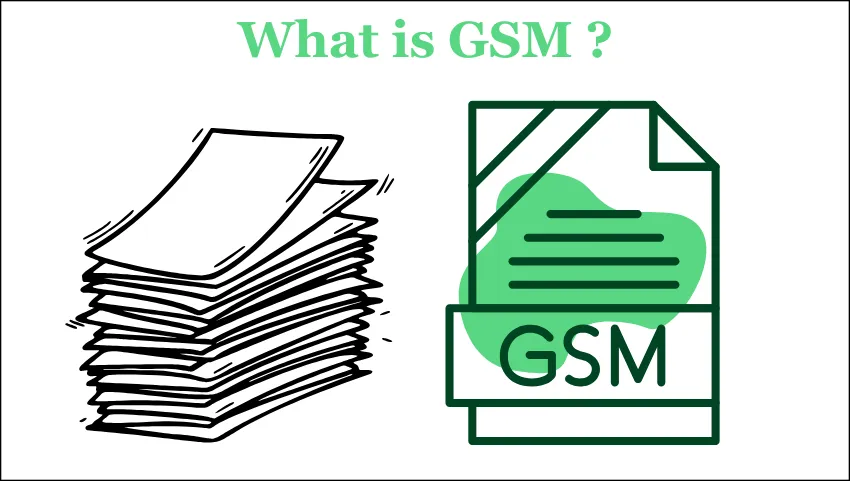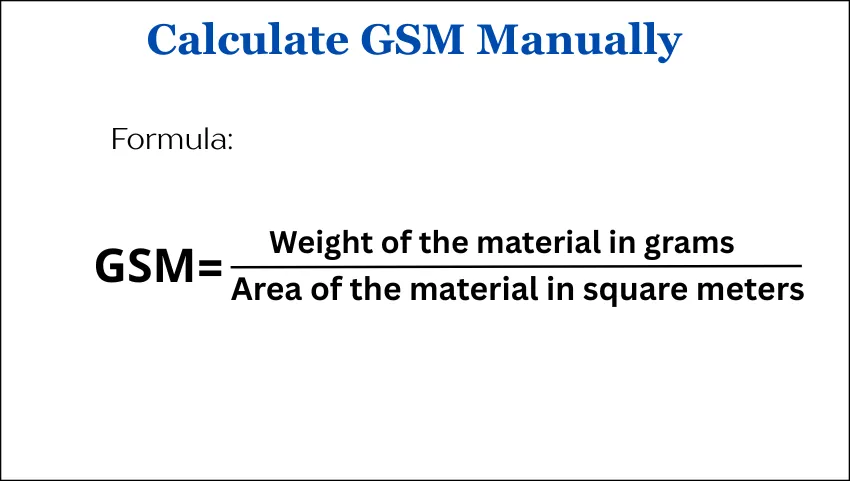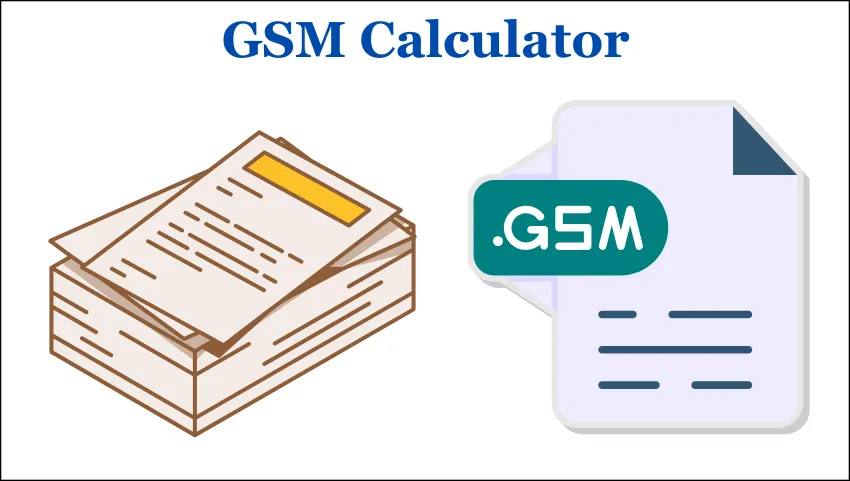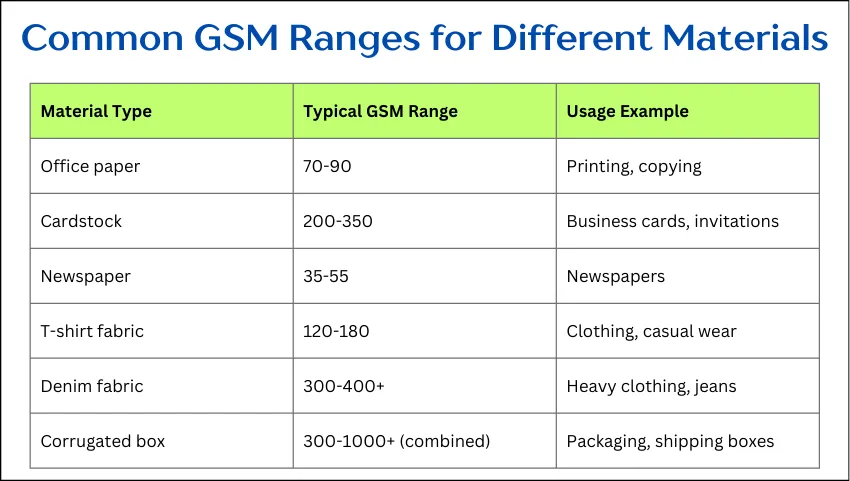GSM Calculator
Calculate paper weight in grams per square meter
What is GSM?
GSM stands for "Grams per Square Meter" and is a standard measurement used to determine the weight and thickness of paper.
Formula: GSM = (Weight in grams × 1,000,000) ÷ (Length in mm × Width in mm × Quantity)
Common GSM values:
• Copy Paper: 70-80 GSM
• Business Cards: 250-350 GSM
• Cardboard: 200-500+ GSM
• Newspaper: 35-48 GSM
Use our free GSM calculator to measure fabric and paper weight quickly. Understand GSM and choose the right material with confidence.
In the world of materials like paper, fabric, and packaging, GSM stands for Gram per Square Meter—it is a crucial measure that tells you the weight and thickness of a material. Simply put, GSM lets you understand how heavy or thick a square meter of a material is. Whether you are buying paper for printing, fabric for clothes, or cardboard for packaging, knowing the GSM helps in making the right choice.
What is GSM? Understanding the Basics
The full form Gram per Square Meter (GSM) describes the weight of a material per one square meter of area. For example:

- If a piece of fabric weighs 200 grams and covers an area of 1 square meter, the fabric is said to be 200 GSM.
- If a sheet of paper weighs 80 grams for every square meter, its GSM is 80.
The higher the GSM, the heavier and usually thicker the material will be. Conversely, a lower GSM means a lighter and thinner material. GSM is like a fingerprint showing a material’s quality and suitability for different uses.
Why is GSM Important?
Knowing the GSM helps you understand:
- Thickness and durability: Higher GSM means thicker fabrics or paper, which can be more durable.
- Suitability: Different uses require different GSMs, e.g., a T-shirt fabric could be between 120-180 GSM, while a heavyweight jacket fabric might be 300 GSM or more.
- Quality selection: In printing or packaging, the GSM determines the feel and strength of paper or cardboard.
For example, in paper printing:
- Ordinary office paper typically has a GSM of 70-90.
- Business cards and postcards often use 250-300 GSM for a sturdy feel.
How to Calculate GSM Manually
Calculating GSM yourself is straightforward using a simple formula:GSM=Area of the material in square meters Weight of the material in grams

Here’s how you can do it step-by-step:
- Weigh a sample of the material—use a digital scale to find the weight in grams.
- Measure the dimensions of the sample—length and width in centimeters or meters.
- Calculate the area in square meters—if you measure in centimeters, convert by dividing by 10,000 (since 100×100=10,000100 \times 100 = 10,000100×100=10,000 cm² equals 1 m²).
- Apply the formula—divide the weight by the area to get the GSM.
Example:
You have a fabric piece that weighs 150 grams and measures 50 cm by 40 cm.
- Area in square meters = 50×4010,000=0.20 m²
- GSM = 1500.20 = 750 GSM
This fabric is quite thick and heavy.
How Does a GSM Calculator Work?
A GSM calculator automates the manual calculation process. You just need to enter:

- Weight of the sample (in grams)
- Length and width of the sample (in cm or m)
The calculator then computes the area and applies the formula internally to display the GSM instantly.
Advantages of Using a GSM Calculator:
- Saves time and effort
- Reduces calculation errors
- Gives precise results quickly
- Helpful for manufacturers and quality testers
GSM Calculation for Different Materials
GSM is not just for paper but for many materials used in different industries. Here’s how it applies:
1. Paper and Printing Industry
Paper quality is often defined by its GSM, which indicates thickness, weight, and sturdiness. For instance:
- Standard A4 paper is about 70-90 GSM.
- Cardstock for business cards or invitations can be 250-350 GSM.
- Newspaper is lighter, often 35-55 GSM.
Knowing the right GSM is essential for printers to choose the correct paper for flyers, brochures, or books.
2. Textile and Fabric Industry
Fabric weight in GSM relates to how heavy or dense the fabric feels. Shirt fabrics may be light (120-150 GSM), while denim is heavier (300+ GSM). Textile manufacturers use GSM to specify fabric quality and feel.
Industries rely on GSM testing machines or calculators to maintain consistent fabric quality.
3. Packaging Industry
For carton boxes and packaging materials, GSM helps determine strength and durability. Corrugated boxes often have combined GSM from different layers, such as liners and fluting.
Tools for Measuring GSM
Manual Tools
- Precision digital scale—for weighing the material in grams.
- Ruler or measuring tape—for accurate measurement of fabric or paper size.
- GSM cutter—a specialized tool that cuts a fixed-size sample (usually 100 cm²), helping simplify calculations.
Automated GSM Measuring Machines
Industries often use machines that quickly measure GSM without manual weighing and measuring. These devices provide instant readings for quality control.
Practical Tips for Accurate GSM Measurement
- Always use a precision scale for accurate weight measurement.
- Measure the area carefully; errors in measurements directly affect GSM results.
- Cut fabric or paper samples cleanly—uneven edges can lead to mistakes.
- If possible, use a GSM cutter for a standardized sample size.
- Use an online or handheld GSM calculator for quick and reliable results.
Common GSM Ranges for Different Materials

| Material Type | Typical GSM Range | Usage Example |
|---|---|---|
| Office paper | 70-90 | Printing, copying |
| Cardstock | 200-350 | Business cards, invitations |
| Newspaper | 35-55 | Newspapers |
| T-shirt fabric | 120-180 | Clothing, casual wear |
| Denim fabric | 300-400+ | Heavy clothing, jeans |
| Corrugated box | 300-1000+ (combined) | Packaging, shipping boxes |
Frequently Asked Questions (FAQs)
What does GSM mean?
GSM stands for Gram per Square Meter. It is the weight in grams of one square meter of material, like fabric or paper.
Why is GSM important?
GSM tells you how heavy and thick a material is. It helps choose the right quality for printing, clothing, or packaging.
How do I calculate GSM manually?
Weigh the material in grams, measure its area in square meters, then divide weight by area:GSM = weight ÷ area.
What tools do I need to measure GSM?
A digital scale to weigh and a ruler or tape to measure dimensions are enough for manual GSM calculation.
Can I use a GSM calculator online?
Yes, online GSM calculators let you enter weight and size to instantly get GSM without doing math.
What is a good GSM for fabric?
It depends on use. Light T-shirts are 120-180 GSM, while heavy denim can be 300 GSM or more.
How does GSM affect paper quality?
Higher GSM means thicker, more durable paper, good for cards; lower GSM is thinner, used for normal printing.
Can I use GSM to compare different materials?
Yes, GSM helps compare weights and thicknesses even if materials look similar.
Summary
A GSM calculator is a valuable tool for anyone working with paper, fabric, or packaging materials. It simplifies the process of determining the weight per square meter of a material, helping make informed choices about quality and use. By understanding GSM, you ensure you select the right material for your needs, whether for printing, clothing, or packaging.
